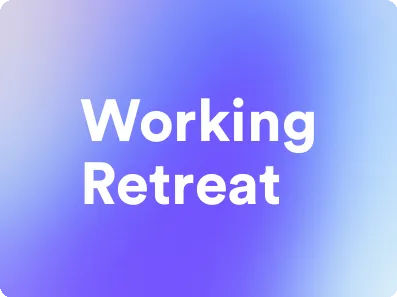Working Retreat: Enhancing Productivity in a Serene Environment
This guide will walk you through the essential elements of using working retreat - the productivity method to keep your team productive and engaged.
Try Lark for Free
Imagine a setting where the tranquility of nature meets the buzz of professional productivity. This is the allure of a working retreat - an endeavor that promises to revolutionize the traditional professional environment and offer a unique approach to fostering productivity, creativity, and holistic well-being. A working retreat provides individuals with an opportunity to immerse themselves in work while being away from the usual office setting. This article will delve into the concept of working retreat, its origin, target audience, advantages, drawbacks, getting started, a step-by-step guide, actionable tips, do's and don'ts, and a comprehensive FAQ section.
What is a Working Retreat?
A working retreat is a dedicated period in which individuals or organizations relocate to a different, often more secluded, environment to focus on work-related tasks without the usual distractions. This concept marries the principles of a traditional retreat, aimed at rejuvenation and self-reflection, with the imperative need for sustained productivity in professional endeavors. The primary objective of a working retreat is to provide a conducive environment for concentrated work, fostering creativity, and achieving professional milestones in a setting that promotes relaxation and well-being.
The underlying philosophy is to offer individuals a break from the routine while enhancing their professional efficiency. By providing an environment that is conducive to deep work and fostering creative insights, a working retreat aims to optimize productivity and rejuvenate the participants.
The Origin of Working Retreat
The concept of the working retreat draws inspiration from the traditional retreat, which has long been associated with spiritual or personal introspection. The adaptation of this practice for professional purposes implies a deliberate shift towards integrating productivity and well-being. The origins of working retreats can be traced back to the growing need for professionals to find innovative solutions to maintaining work-life balance and sustaining their productivity levels in an increasingly fast-paced and demanding work environment.
Use Lark to unleash your team productivity.
Who Can Benefit from a Working Retreat?
The benefits of a working retreat are far-reaching and cater to a wide array of individuals, including:
- Entrepreneurs: Independent business owners seeking a break from their usual workspace to recalibrate and strategize.
- Freelancers: Self-employed professionals aiming to refocus their efforts and leverage novel environments for inspiration.
- Corporate Teams: Organizations looking to break away from the traditional office setting to foster team creativity and innovation.
Pros and Cons of Working Retreat
Pros
- Enhanced Focus: A change in environment often leads to increased concentration and deep work.
- Rejuvenation: The serene backdrop can be a source of mental and emotional rejuvenation.
- Creativity Boost: Access to a stimulating environment can spur new ideas and innovation.
Cons
- Logistical Challenges: Organizing a working retreat may involve complex logistics.
- Potential Distractions: The new environment could introduce distractions that disrupt the work process.
- Cost Considerations: Budget constraints could pose a hurdle for some individuals or organizations.
Learn more about Lark x Productivity
Getting Started with a Working Retreat
Embarking on a working retreat requires careful planning and consideration. To initiate this transformative experience, individuals and organizations can follow the steps outlined below:
- Define the Objectives: Clearly outline the purpose and expected outcomes of the working retreat.
- Select the Location: Identify a serene and conducive environment that aligns with the objectives.
- Logistical Planning: Organize the travel, accommodation, and workspace arrangements.
- Pre-Retreat Communication: Communicate the details, expectations, and agenda to all participants.
Use Lark to unleash your team productivity.
Actionable Tips for a Fulfilling Working Retreat
- Embrace Nature: Encourage outdoor activities and integrate nature-based mindfulness practices.
- Establish Boundaries: Set specific work hours and create designated spaces for work and relaxation.
- Encourage Collaboration: Foster an environment where participants can share insights and collaborate on projects.
- Cultivate Mindfulness: Incorporate mindfulness exercises and relaxation techniques into the retreat agenda.
